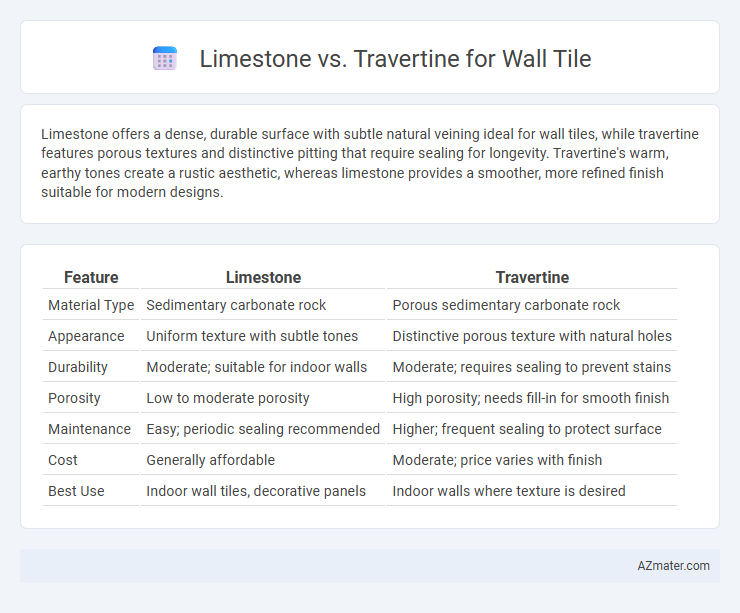Limestone offers a dense, durable surface with subtle natural veining ideal for wall tiles, while travertine features porous textures and distinctive pitting that require sealing for longevity. Travertine's warm, earthy tones create a rustic aesthetic, whereas limestone provides a smoother, more refined finish suitable for modern designs.
Table of Comparison
| Feature | Limestone | Travertine |
|---|---|---|
| Material Type | Sedimentary carbonate rock | Porous sedimentary carbonate rock |
| Appearance | Uniform texture with subtle tones | Distinctive porous texture with natural holes |
| Durability | Moderate; suitable for indoor walls | Moderate; requires sealing to prevent stains |
| Porosity | Low to moderate porosity | High porosity; needs fill-in for smooth finish |
| Maintenance | Easy; periodic sealing recommended | Higher; frequent sealing to protect surface |
| Cost | Generally affordable | Moderate; price varies with finish |
| Best Use | Indoor wall tiles, decorative panels | Indoor walls where texture is desired |
Introduction to Limestone and Travertine Wall Tiles
Limestone wall tiles are sedimentary rocks composed mainly of calcite, offering a smooth, natural texture with subtle color variations ideal for classic and contemporary interiors. Travertine tiles form from mineral springs and display a distinctive porous surface with unique veining patterns, providing an elegant, rustic aesthetic. Both materials are durable and suitable for indoor applications, with travertine often requiring sealing due to its natural permeability.
Formation and Geological Differences
Limestone forms from the accumulation of marine organism remains, primarily composed of calcium carbonate, creating a sedimentary rock with a fine-grained texture. Travertine, a type of limestone, forms through the rapid precipitation of calcium carbonate from mineral springs, often resulting in a porous and banded appearance due to its unique deposition process. The geological differences lie in their formation environments: limestone typically develops in calm marine settings, while travertine is associated with freshwater springs and geothermal activity, influencing their durability and aesthetic qualities for wall tile applications.
Appearance and Color Variations
Limestone wall tiles offer a soft, matte finish with subtle, earthy tones ranging from creamy beige to warm grey, creating a natural, understated elegance ideal for both classic and contemporary spaces. Travertine wall tiles present a more textured appearance, characterized by natural pits and troughs, with a broader color palette including warm tans, rich browns, golden hues, and occasional reddish tones that provide a rustic, sophisticated charm. The distinct surface qualities and color variations of limestone and travertine allow for tailored design choices suited to different aesthetic preferences and architectural styles.
Durability and Strength Comparison
Limestone and travertine wall tiles both offer unique aesthetic qualities but differ significantly in durability and strength. Limestone typically exhibits greater hardness and density, making it more resistant to scratches and wear, while travertine's porous structure requires sealing to prevent damage from moisture and staining. For high-traffic or moisture-prone wall applications, limestone provides superior long-term durability compared to the softer, more absorbent travertine.
Porosity and Moisture Resistance
Limestone exhibits higher porosity compared to travertine, making it more susceptible to moisture absorption and potential staining when used as wall tile. Travertine's dense composition and natural tufa deposits create a less porous surface, enhancing its moisture resistance and durability in humid environments. Proper sealing is essential for both stones, but travertine generally offers better performance in areas prone to moisture exposure.
Maintenance and Cleaning Requirements
Limestone wall tiles require regular sealing due to their porous nature, which helps prevent staining and moisture absorption, while travertine tiles also need sealing but often benefit from filling of natural pits to create a smoother surface. Both materials should be cleaned with pH-neutral, non-abrasive cleaners to avoid etching or damage, avoiding acidic or alkaline substances that can degrade the stone's surface. Routine maintenance involves gentle wiping and prompt spill cleanup to preserve the natural beauty and longevity of limestone and travertine wall tiles.
Installation Process and Challenges
Limestone wall tiles require careful sealing and cutting due to their porous nature and tendency to absorb moisture, making the installation process more labor-intensive and susceptible to damage if not handled properly. Travertine, while also porous, typically features natural voids that necessitate filling before installation, adding extra preparation time but providing a more durable and stable surface once completed. Both materials demand skilled labor for precise alignment and sealing to prevent staining and ensure longevity in wall applications.
Cost Comparison and Value
Limestone wall tiles typically cost between $8 to $15 per square foot, while travertine ranges from $7 to $20 per square foot depending on quality and finish. Travertine offers higher durability and distinctive veining, often providing better long-term value despite its potentially higher upfront cost. Choosing travertine can enhance property value due to its premium aesthetic and resilience, whereas limestone may appeal for budget-conscious projects with moderate durability needs.
Best Applications for Each Material
Limestone wall tiles excel in indoor applications like bathrooms and living rooms due to their subtle texture and ability to complement various interior styles with natural warmth. Travertine, with its porous surface and distinctive veining, is ideal for accent walls, fireplaces, and outdoor spaces where durability and a rustic aesthetic are desired. Both materials perform well in low-traffic areas, but travertine's resistance to moisture makes it more suitable for exterior wall cladding and humid environments.
Pros and Cons: Limestone vs Travertine
Limestone wall tiles offer a softer, more uniform texture with excellent durability, but they are prone to scratching and require regular sealing to prevent staining. Travertine provides a distinctive, porous surface with natural pits and variegated patterns that enhance its aesthetic appeal, though it may require filling and more maintenance to maintain its appearance. Both stones are suitable for interior walls, but limestone tends to be more resistant to wear, while travertine offers a warmer, more rustic look.

Infographic: Limestone vs Travertine for Wall Tile
 azmater.com
azmater.com